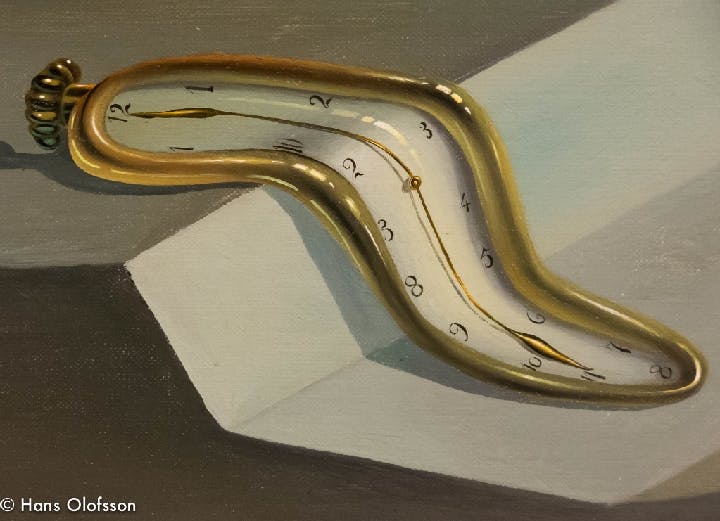Summer 2012
A Brief History of Internal Time
– Rob Dunn
The story of the daily rhythms of our bodies begins with the study of the skies.
It's late, and, as always, I have lots of things I’d like to do before I go to bed. I don’t sleep much. I enjoy being awake. My dreams are quiet, but my days are full of things to explore, the treasures of ordinary life. So when I began to read Till Roenneberg’s Internal Time, a book whose dust jacket mentions sleep and biological clocks, I was hoping to find a passage clearly stating that those who sleep less are happier and wiser, and live longer, or at least are more interesting to talk to at parties. I didn’t find it, but the book was fascinating, and so I read on, and now, at 11 p.m., I have begun to write.
The story of the daily rhythms of our bodies begins with the study of the skies. In 1729, French astronomer Jean Jacques d’Ortous de Mairan found himself wondering how the Earth’s spin affected the species around him. He kept a mimosa, one of his favorite plants, on a windowsill near his desk. Leaves furled, it slept even when he could not, and so he decided to stay up a little longer and study how it knew what to do during the day and night. De Mairan put his plant in the cupboard. There it did as it had always done, opening all of its leaves simultaneously at daybreak and closing them at night. Somehow the plant knew what was going on outside the cabinet. That was the end of de Mairan’s experiment; he left the rhythm of mimosas observed but unexplained.
In 24 easy-to-read chapters, Roenneberg proposes to explain what de Mairan did not and to tell us why the circadian rhythms in our bodies matter in our daily lives. Other books have dealt with our biological clocks, but Roenneberg focuses on the ways in which societal pressures seem to be leading us to disregard our clocks, at considerable cost.
Your body is set, more or less, on 24-hour days, but just when those cycles begin and end is “entrained” by light. Receptors in your eyes (apart from those rods and cones you learned about in school) tell you if it is day or night. These receptors are not wired to your conscious brain, but to a special part of the subconscious brain called the suprachiasmatic nucleus, in essence, your timekeeper. The timekeeper signals the pineal gland what to say to the body via hormones such as melatonin (whether it be “night, night, night” or “day, day, day”). At night our temperature decreases, and our cortisol production declines. Even our metabolism waxes and wanes. All of this happens without us ever thinking about it, the tides of our bodies pulled by invisible and very ancient forces.
Roenneberg spends a lot of time discussing what are known as chronotypes—categories of individuals who differ in their sleep rhythms, whether because they need more or less sleep or tend to be early wakers or late wakers. But as Roenneberg points out, such chronotypes do not really exist as categories. Instead, like other complicated attributes of living things, the variation among individuals is continuous (and relatively modest—we vary less in rhythm than in height). Most people are neither lark nor owl but human, falling somewhere along a continuum. Most of us need between seven and a half and eight and a half hours of sleep (but get less). Some turn in early, others late, though very few people wake up before five or after ten.
More to the point, while we differ in our timing, the biggest differences in our degree of larkiness have to do with age. Teenagers are the weirdest ones. They are innately late risers, getting up (in the absence of alarm clocks and parental intervention) several hours later than younger kids or adults. Get them up too early and they are mean, silly, and not as clever as they might be later in the day. As we age, we rise earlier and earlier.
Roenneberg not only explains our daily cycles but also asks us to re-evaluate the extent to which we allow society to push us toward longer days and artificial waking times. He argues that it behooves us to rewild our cycles and live in a way that recognizes our natural rhythms, whether that means allowing teenagers to wake up later, living like larks or owls if that is our nature, or just sleeping more.
I like being awake. From Roenneberg’s perspective, spending more time awake than I should is a sort of vice I should try to combat. He is probably right, but I find solace in noting that de Mairan discovered circadian rhythms while working so late at night he could barely hold his quill. Meanwhile, I better wrap this up because I see it is now 4 a.m. and the damned larks, those early risers, have just begun to sing.
Rob Dunn, a biologist at North Carolina State University, is the author of The Wild Life of Our Bodies: Predators, Parasites, and Partners That Shape Who We Are Today (2011) and Every Living Thing: Man’s Obsessive Quest to Catalog Life, From Nanobacteria to New Monkeys (2008).
Reviewed: Internal Time: Chronotypes, Social Jet Lag, and Why You’re So Tired by Till Roenneberg, Harvard University Press, 272 pp.
Photo courtesy of Flickr/Hans Olofsson
